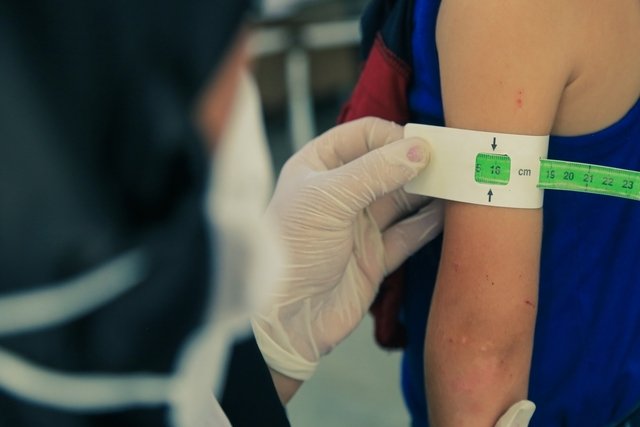Marasmus is a type of severe malnutrition caused by a lack of calories in the diet, which causes the body to use the body’s energy reserves, causing symptoms such as low weight, delayed child growth, dehydration, irritation and diarrhea.
Marasmus can be caused by situations such as inadequate food intake, anorexia, early weaning, chronic diarrhea or dementia, affecting mainly children, but can also appear in adults.
The diagnosis of marasmus must be made by a general practitioner or pediatrician and the treatment of this condition may include the use of antibiotics, nutritional formulas and supplements such as vitamin B1 and phosphate.
Main symptoms of marasmus
The main symptoms of marasmus are:
- Visible loss of muscle mass;
- Very low weight for the child’s age and delayed development;
- Aged appearance;
- Larger head size in relation to the body;
- Apathy, which is characterized by a lack of motivation, feeling or emotion;
- Tiredness and irritability;
- Wavy nails and thin, brittle hair, which may lead to hair loss;
- Changes in consciousness;
- Dehydration, which can be seen by dry eyes, dry, wrinkled skin and deep soft spots in babies;
- Decrease in body temperature, heart rate and blood pressure;
- Vomiting and diarrhea.
In addition, a person with marasmus may also have anemia, osteomalacia or rickets, a disease that affects bone development, causing bowing of the legs and arms in children. Find out more about the symptoms of rickets.
Difference of Marasmus and Kwashiorkor
Kwashiorkor is a type of severe malnutrition characterized by extreme protein deficiency in the diet, causing symptoms such as swelling in the belly, face, hands and feet, and changes in skin and hair color. Check out more about Kwashiorkor.
Marasmus is a serious malnutrition caused by a diet low in total calories, and which does not cause swelling in the body or changes in the color of the skin and hair.
How to confirm the diagnosis
The diagnosis of marasmus must be made by a nutritionist, pediatrician or general practitioner initially through a physical examination, in which the person is weighed and height, skin folds and body circumferences are measured.
Furthermore, to rule out Kwashiorkor, the doctor also investigates the presence of edema, that is, if there is an accumulation of fluid in the abdomen, hands, face and feet.
In addition, the doctor also orders blood, fecal and urine tests to assess vitamin and mineral deficiencies, worm infections, protein and blood glucose levels or HIV.
Make an appointment with your nearest doctor to assess your risk of marasmus:
Possible causes
The main cause of marasmus is insufficient total caloric intake. Thus, some factors that may contribute to the emergence of this disease are:
- Food shortage;
- Anorexia;
- Diseases that cause malabsorption, such as short bowel syndrome, inflammatory bowel disease, celiac disease, pancreatic insufficiency, pancreatitis and chronic diarrhea;
- Insanity;
- Depression, which can cause loss of appetite;
- Early weaning, in the case of children.
Furthermore, some aspects that contribute to the development of doldrums are poverty and food shortages, and neglect of the elderly.
How the treatment is carried out
Marasmus treatment must be carried out by a doctor and must be divided into 3 phases:
1. Stabilization
This phase of treatment should preferably be carried out in the hospital, lasts around 7 days and aims to increase hydration, avoid infections and hypothermia. Therefore, it is recommended to keep the person warm and use an isotonic solution, which must be administered into a vein. The use of antibiotics may also be indicated in cases of infection.
Feeding must be done using nutritional formulas, orally or using tubes, and calorie intake must be between 60% and 80% of the caloric need for age. Feeding should be done gradually to avoid refeeding syndrome, a complication that can cause arrhythmia and sudden death within a few days, after feeding people with severe malnutrition.
Additionally, supplements such as vitamin B1 and phosphate may also be indicated to prevent refeeding syndrome.
2. Nutritional rehabilitation
This phase lasts between 2 and 6 weeks, starting after the treatment of marasmus complications. Therefore, you can gradually increase the calories in your diet, which can vary from 70 to 140% of the nutritional needs for your age, including the use of nutritional formulas and gradually evolving towards the consumption of solid foods.
3. Monitoring and prevention
At this stage, the child is monitored periodically with the aim of preventing the resurgence of the disease. Thus, some recommendations include vaccination, breastfeeding, care during food preparation and the use of filtered or boiled water.
In addition, parents or caregivers should be instructed on how to recognize the signs of possible malnutrition, such as weight loss, diarrhea, tiredness and low body temperature. Learn about other symptoms of malnutrition.
Complications of marasmus
When marasmus is not properly identified and treated, there is a greater risk of complications such as infections, dehydration, electrolyte imbalance and heart failure. Furthermore, there is a risk of death due to the appearance of refeeding syndrome.

Sign up for our newsletter and stay up to date with exclusive news
that can transform your routine!
Warning: Undefined array key "title" in /home/storelat/public_html/wp-content/plugins/link-whisper-premium/templates/frontend/related-posts.php on line 12
Warning: Undefined array key "title_tag" in /home/storelat/public_html/wp-content/plugins/link-whisper-premium/templates/frontend/related-posts.php on line 13




